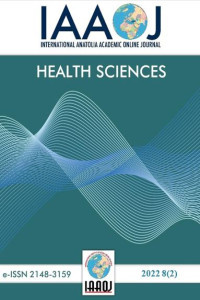OBSTRÜKTİF UYKU APNE SENDROMLU HASTALARDA GÜNDÜZ AŞIRI UYKULULUK HALİNİ ETKİLEYEN FAKTÖRLER
Gündüz Aşırı Uykululuk Hali, Obtrüktif Uyku Apne Sendromu, Polisomnografi
FACTORS INFLUENCING EXCESSIVE DAYTIME SLEEPINESS in PATIENTS with OBSTRUCTIVE SLEEP APNEA SYNDROME
___
- 1. Sateia MJJC. International classification of sleep disorders. 2014;146(5):1387-94.
- 2. Sassani A, Findley LJ, Kryger M, Goldlust E, George C, Davidson TMJS. Reducing motor-vehicle collisions, costs, and fatalities by treating obstructive sleep apnea syndrome. 2004;27(3):453-8.
- 3. Uehli K, Mehta AJ, Miedinger D, Hug K, Schindler C, Holsboer-Trachsler E, et al. Sleep problems and work injuries: a systematic review and meta-analysis. 2014;18(1):61-73.
- 4. Mulgrew A, Ryan C, Fleetham J, Cheema R, Fox N, Koehoorn M, et al. The impact of obstructive sleep apnea and daytime sleepiness on work limitation. 2007;9(1):42-53.
- 5. Garbarino S, Scoditti E, Lanteri P, Conte L, Magnavita N, Toraldo DMJFin. Obstructive sleep apnea with or without excessive daytime sleepiness: clinical and experimental data-driven phenotyping. 2018;9:505.
- 6. Zhou J, Camacho M, Tang X, Kushida CAJSm. A review of neurocognitive function and obstructive sleep apnea with or without daytime sleepiness. 2016;23:99-108.
- 7. Prasad B, Steffen AD, Van Dongen HP, Pack FM, Strakovsky I, Staley B, et al. Determinants of sleepiness in obstructive sleep apnea. 2018;41(2):zsx199.
- 8. Littner MR, Kushida C, Wise M, G. Davila D, Morgenthaler T, Lee-Chiong T, et al. Practice parameters for clinical use of the multiple sleep latency test and the maintenance of wakefulness test. 2005;28(1):113-21.
- 9. Johns MWJs. A new method for measuring daytime sleepiness: the Epworth sleepiness scale. 1991;14(6):540-5.
- 10. Al-Abri MA, Al-Adawi S, Al-Abri I, Al-Abri F, Dorvlo A, Wesonga R, et al. Daytime sleepiness among young adult Omani car drivers. 2018;18(2):e143.
- 11. Lanza A, Mariani S, Sommariva M, Campana C, Rubino A, Nichelatti M, et al. Continuous positive airway pressure treatment with nasal pillows in obstructive sleep apnea: long-term effectiveness and adherence. 2018;41:94-9.
- 12. Patel S, Kon SS, Nolan CM, Barker RE, Simonds AK, Morrell MJ, et al. The Epworth Sleepiness Scale: minimum clinically important difference in obstructive sleep apnea. 2018;197(7):961-3.
- 13. Thorarinsdottir EH, Bjornsdottir E, Benediktsdottir B, Janson C, Gislason T, Aspelund T, et al. Definition of excessive daytime sleepiness in the general population: Feeling sleepy relates better to sleep‐related symptoms and quality of life than the Epworth Sleepiness Scale score. Results from an epidemiological study. 2019:e12852.
- 14. Ramar K, Olson EJ. Management of common sleep disorders. American family physician. 2013;88(4):231-8.
- 15. Chen R, Xiong KP, Lian YX, Huang JY, Zhao MY, Li JX, et al. Daytime sleepiness and its determining factors in Chinese obstructive sleep apnea patients. Sleep & breathing = Schlaf & Atmung. 2011;15(1):129-35.
- 16. Castiglioni P, Lombardi C, Di Rienzo M, Lugaresi E, Montagna P, Cortelli P, et al. What are the causes of excessive daytime sleepiness in patients with sleep-disordered breathing? The European respiratory journal. 2008;32(2):526-7.
- 17. Young T, Peppard PE, Gottlieb DJJAjor, medicine cc. Epidemiology of obstructive sleep apnea: a population health perspective. 2002;165(9):1217-39.
- 18. Veasey SC, Davis CW, Fenik P, Zhan G, Hsu Y-J, Pratico D, et al. Long-term intermittent hypoxia in mice: protracted hypersomnolence with oxidative injury to sleep-wake brain regions. 2004;27(2):194-201.
- 19. Gami AS, Olson EJ, Shen WK, Wright RS, Ballman KV, Hodge DO, et al. Obstructive sleep apnea and the risk of sudden cardiac death: a longitudinal study of 10,701 adults. 2013;62(7):610-6.
- 20. Sun Y, Ning Y, Huang L, Lei F, Li Z, Zhou G, et al. Polysomnographic characteristics of daytime sleepiness in obstructive sleep apnea syndrome. 2012;16(2):375-81.
- 21. Swanson LM, Arnedt JT, Rosekind MR, Belenky G, Balkin TJ, Drake CJJosr. Sleep disorders and work performance: findings from the 2008 National Sleep Foundation Sleep in America poll. 2011;20(3):487-94.
- 22. Chen Y-C, Chen T-W, Su M-C, Chen C-J, Chen K-D, Liou C-W, et al. Whole genome DNA methylation analysis of obstructive sleep apnea: IL1R2, NPR2, AR, SP140 methylation and clinical phenotype. 2016;39(4):743-55.
- 23. Castiglioni P, Lombardi C, Cortelli P, Parati GJERJ. Why excessive sleepiness may persist in OSA patients receiving adequate CPAP treatment. 2012;39(1):226-7.
- 24. Bixler E, Vgontzas A, Lin H-M, Calhoun S, Vela-Bueno A, Kales AJTJoCE, et al. Excessive daytime sleepiness in a general population sample: the role of sleep apnea, age, obesity, diabetes, and depression. 2005;90(8):4510-5.
- 25. Muraja-Murro A, Nurkkala J, Tiihonen P, Hukkanen T, Tuomilehto H, Kokkarinen J, et al. Total duration of apnea and hypopnea events and average desaturation show significant variation in patients with a similar apnea–hypopnea index. 2012;36(8):393-8.
- Yayın Aralığı: Yılda 3 Sayı
- Başlangıç: 2013
- Yayıncı: Abdülkadir IŞIK
ÇOCUKLARDA BESLENME SORUNLARI ve ÇÖZÜM YOLLARI
Çiğdem Müge HAYLI, Mehmet Zeki AVCI
OBSTRÜKTİF UYKU APNE SENDROMLU HASTALARDA GÜNDÜZ AŞIRI UYKULULUK HALİNİ ETKİLEYEN FAKTÖRLER
Hakan CELİKHİSAR, Gülay DAŞDEMİR İLKHAN
TALASEMİ MAJORLÜ ERGENLERİN UMUT DÜZEYLERİNİ ETKİLEYEN FAKTÖRLER
Derya DEMİR UYSAL, Hüsniye ÇALIŞIR
TİP 2 DİYABET HASTALARININ HASTALIKLARI İLE BAŞ ETMELERİNDE KARŞILAŞTIKLARI ENGELLERİN BELİRLENMESİ
Ayşe KACAROĞLU VİCDAN, Ülkü DEMİRKAN YAPAR
İLKÖĞRETİM ÖĞRENCİLERİNİN OKUL TUVALETLERİNİ KULLANMA DURUMU VE ETKİLEYEN FAKTÖRLER
Ayşe SEZER BALCI, Nurcan KOLAC, Elif KESKİN, Rahime POYRAZ
0-3 AY ARASI BEBEK SAHİBİ ANNELERİN ANNE SÜTÜ İLE BESLENME BİLGİ DÜZEYİNİN DEĞERLENDİRİLMESİ
Muhammet Mesut Nezir ENGİN, Önder KILIÇASLAN, Merve ASLANTAŞ, Kenan KOCABAY
